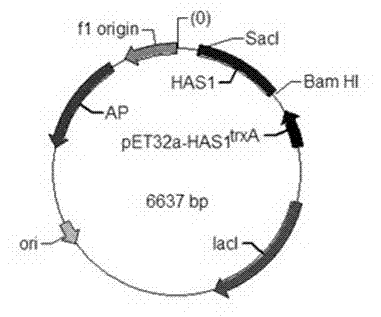Clone, expression and application of antimicrobial protein HAS1 encoding gene
A technology that encodes genes and antibacterial proteins is applied in the fields of application, genetic engineering, and plant genetic improvement, and can solve problems such as sugarcane smut that has not yet been seen
- Summary
- Abstract
- Description
- Claims
- Application Information
AI Technical Summary
Problems solved by technology
Method used
Image
Examples
Embodiment 1
[0038] 1. Screening and identification of antagonistic bacteria of plant pathogenic fungi
[0039] Screening of bacterial strains: Weigh 5 grams of rhizosphere soil (the rhizosphere soil of sugarcane plants in the plot where sugarcane smut occurs seriously in Lingao County, Hainan Province, my country), put it into a triangular flask with 100ml sterile water, and put it on a shaker. After shaking vigorously for 30 minutes, let stand for 15 minutes. Take 1ml and dilute to 10 -4 、10 -5 、10 -6 Concentration gradient, take 0.1ml from each concentration gradient suspension, and spread it on LB medium with a sterile stick (the formula is: each liter contains 10g of peptone, 5g of yeast powder, 10g of NaCl, 12g of agar powder, pH7.0~7.2) On the plate, cultured upside down in a constant temperature incubator at 30°C, observed continuously for 3 days, picked strains with different colony shapes, streaked again, purified and stored for later use. Coat the teliospores of sugarcane smu...
PUM
 Login to View More
Login to View More Abstract
Description
Claims
Application Information
 Login to View More
Login to View More - R&D
- Intellectual Property
- Life Sciences
- Materials
- Tech Scout
- Unparalleled Data Quality
- Higher Quality Content
- 60% Fewer Hallucinations
Browse by: Latest US Patents, China's latest patents, Technical Efficacy Thesaurus, Application Domain, Technology Topic, Popular Technical Reports.
© 2025 PatSnap. All rights reserved.Legal|Privacy policy|Modern Slavery Act Transparency Statement|Sitemap|About US| Contact US: help@patsnap.com



